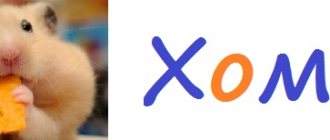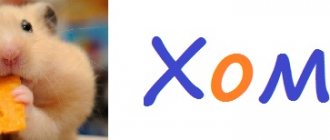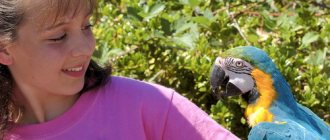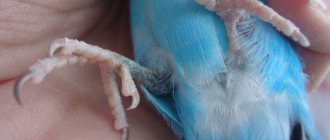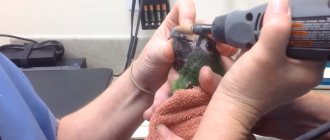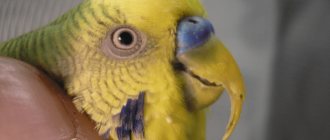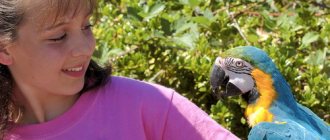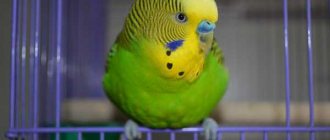Water is the source of life for any organism. Parrots are no exception to this. Living in captivity, birds consume less liquid. This is explained by the small amount of energy expended, in contrast to the natural habitat. Some species of parrots can go without drinking for a long time. Because the true nature of their habitats forces birds to fly long distances in search of food.
The concern of new owners who think that the parrot does not drink water is in some cases in vain. Parrots require a small amount of liquid to function normally. If the owner does not notice his pet drinking, then the bird has probably already had a drink in his absence.
Reasons for refusing fluids:
- Stress associated with moving, new people, loud noises from pets;
- Inadequate quality of water used;
- Wrong choice of drinking bowl;
- Diseases.
Daily feed and water intake
When keeping poultry, it is not only underfeeding that is dangerous, but also excessive amounts of food. Each species has its own diet, which must be studied before getting a pet.
- Budgerigar. This species requires about 1.5-2 teaspoons of grain feed per day. It is best to divide them into several servings so that the bird does not feel too hungry. Additionally, your budgie can be given pieces of fruits and vegetables. The drinking bowl should always be filled with fresh water. It needs to be changed once a day.
- Macaw. To keep this parrot full, it needs 60 grams or 3.5 tablespoons of food per day. The basis of the mixture should be grains (from 60 to 70%), the rest should be plant foods and root vegetables. The owner must also monitor the water in the macaw's cage. Since it is recommended to pour it into a bowl, the liquid quickly becomes dirty. Therefore, you need to change the water twice a day.
- Corella. The daily food intake for this species is 40 grams or 2-2.5 tablespoons. Ideally, it should be divided into two parts - a spoonful in the morning and evening. The bird should always have access to clean water, so once a day you need to pour new drink into the drinking bowl.
- Cockatoo. Adult birds require 50-60 grams or 3-3.5 tablespoons of grain feed daily, as well as fresh fruits and vegetables. The norm is divided into two approaches: morning and evening. The water is changed once a day.
How to choose the right drinker
Often, owners do not think about buying a special device and simply put a cup or saucer of water in the cage. This is a bad decision - it will be inconvenient for the bird to sit on the side to drink. Such utensils are easy to knock over, so the floor in the cage will be constantly wet. In modern pet stores you can find much more convenient options for drinking bowls:
- Open - a simple metal or plastic model with hooks on the side. Due to the attachment to the bars of the cage, water cannot be spilled, but the open bowl quickly becomes contaminated with the remains of food and droppings. Parrots also often use open containers for bathing and preening;
- Closed - have a plastic roof that prevents the parrot from using the bowl for bathing, and also protects from most of the fluff and droppings that can get into the water;
- Vacuum (automatic) - the best option for installation in a cage; water flows into a small container below as soon as it is emptied. This model is not subject to contamination, so it does not require checking and replacing water during the day.
An ordinary plastic drinker is not suitable for a large parrot - it will quickly break it with its powerful beak. For large birds, it is recommended to install open-type metal bowls or special devices with a ball, which are usually used in rabbit cages. The disadvantage of this design is that it is difficult to clean; you will need to purchase a special brush to remove plaque from the walls.
When buying a drinking bowl for a parrot, it is better to ask the seller at the pet store to show you how to properly attach it to the bars of the cage. It is better to install the device in the corner opposite from the feeder so that pieces of food do not fall into the water. It is important to remember that parrots naturally drink fresh running water, so the container must be washed and refilled every day, regardless of the degree of contamination.
Why did the parrot stop eating?
A bird may refuse to eat for a variety of reasons. Sometimes they are quite harmless: the pet does not like the mixture or a specific product. He may also experience slight stress due to changes in the cage or outside - then the loss of appetite is also only a temporary phenomenon that should go away on its own.
When moving to a new cage, a parrot cannot always quickly find a feeder and drinker. To prevent him from suffering, it is better to temporarily place a few more containers on the bottom with a minimum amount of food. This will help the bird calm down faster.
In other cases, refusal to eat indicates gastrointestinal disorders. It can be affected by prolonged stress, poisoning from low-quality or expired food, or illness. If the parrot does not eat, and at the same time he has diarrhea, blood in the droppings, convulsions, immobility, you need to urgently make an appointment with a veterinarian.
How to accustom a parrot to a drinking bowl
Many owners notice that a new pet does not know how to drink from closed or vacuum type models - in such cases, a decision is usually made to install an open type device. But it’s not at all difficult to accustom a parrot to an automatic waterer. It is enough to remove any other sources of water from the cage - a curious bird will sequentially inspect all corners and devices and, over time, will inevitably discover a drinking bowl. To speed up the learning process, you can put fruit juice in the drinker - attracted by the smell, the parrot will quickly learn to use the device. It is also recommended to place the automatic drinker exactly in the place where the open one previously hung.
Why doesn't the parrot drink?
It is not always possible to accurately determine whether a pet has lost interest in water. Parrots drink a little, especially if their diet includes berries, fruits, vegetables, and herbs. Sometimes a bird refuses fluid due to anxiety associated with changing its cage, drinking bowl, or any other elements of its environment. As in the case of food, it is better to place several drinking bowls at once in a new home.
It is important to know the symptoms of dehydration, which will help the owner understand that something is wrong with his ward. The main signs are lethargy, sunken and constantly closing eyes, cold paws. They appear within a day after the onset of dehydration. To provide timely and competent assistance, you must contact a veterinary clinic. If the parrot does not drink water, but is still active as before, there is no need to worry about it.
Liquid quality
One of the most important points is the presence of clean and high-quality liquid. The water in the drinking bowl should always be fresh. It is not recommended to use tap liquid. Its quality, in most cases, remains questionable; its composition may include pathogenic organisms.
One of the reasons why a bird refuses water is stress from a sudden change in environment. This phenomenon is temporary. After adaptation, fluid intake is normalized. The water temperature in the drinking bowl should be 15 degrees. Colder temperatures can harm the bird and lead to colds. Too warm - does not remove thirst well. The parrot does not want to drink water because it is of poor quality.
ADVICE! The best choice would be to use a bottled product that has been highly purified and loaded with beneficial minerals.
How to help a parrot
Observing the pet will help you decide what to do if the parrot does not eat or drink water. It is important to understand how much and how quickly his behavior has changed, and how these changes are expressed. There are quite a lot of factors that only temporarily plunge a parrot into this state, and most often they all cause stress.
How to help a parrot cope with stress?
- Create calm conditions;
- Do not make loud noises near the cage;
- Do not bring other animals or people unfamiliar to the bird into the room;
- Open the cage only to fill the feeder and change the drinker;
- Try to calm the bird down by talking to it gently and quietly.
Changes in the color and structure of droppings, lethargy, silence, constantly closed eyes - all this indicates that the bird has been poisoned or sick. In this case, it cannot be treated on your own, as this may end badly for the pet. The only way out is to make an appointment with a veterinarian.
Diseases - as a reason for refusing to drink
The owner should really be concerned when refusal to drink is accompanied by signs of illness:
- the appearance of liquid droppings;
- loss of appetite;
- lethargic behavior;
- vomit.
The above symptoms may indicate poultry poisoning. The reason could be:
- eating prohibited foods;
- intoxication by indoor plants (if the bird has free range);
- poor quality food or contaminated water.
In the parrot's body, poisoning causes powerful intoxication. The cardiovascular system, brain, liver and other organs suffer. The bird refuses not only drink, but also food. Stops reacting to others. In such a situation, immediate veterinary attention is required. All necessary measures should be taken as soon as possible. Refusal to drink and diarrhea lead to severe dehydration, which can cause the death of your pet.
NOTE!
Treatment is prescribed by an ornithologist. If there are no clinics or veterinarians in the owner’s place of residence, then help can be found in online resources.
At home, Activated carbon, Enteros gel or smecta are used as medications. You can use Polysorb. The dosage and number of doses are individual for each type. The bird receives the medicine using a syringe or medicine pipette through its beak. All diseases with a severe form can cause a parrot’s reluctance to consume food and water. This behavior indicates the pet’s powerlessness, requiring immediate human intervention and assistance.
Such diseases include colds, infections, disorders of the gastrointestinal tract, as well as injuries to the brain and internal organs received during free range. One of the signs why a parrot has stopped drinking water is its diet. An individual who happily consumes vegetables, fruits and herbs is able to almost fully receive the required amount of fluid for normal existence.
How long can a parrot live without food and water?
The first thing that parrot owners think about when there are changes in eating behavior is how long their pet can last. On average, without food, both small and large parrots will live a maximum of 2-3 days. During this time, the hunger strike will greatly affect the animal: it will develop severe gastrointestinal and feather disturbances, and lethargy. Ultimately this will lead to death. If it is a very young parrot or an old one, or if it has health problems, it will die even earlier.
A bird can only live for a day without water. She constantly needs to drink fluids due to her high body temperature, fast metabolism and the abundance of dry grain food. Clean water is much more important for your pet, which is why you need to pay so much attention to the water bowl.
Why should you get a feathered pet?
Parrots are social creatures that can give a lot of positive emotions and impressions to their owner. In addition, such pets have a number of advantages over other pets:
- Parrots can also be owned by people who are prone to allergies. Since parrots do not have hair, manifestations of allergies in their owners are extremely rare.
- Feathered pets do not need to be walked every day. In order for your parrot to have an active rest, you just need to open the cage and let him out into the room for a walk.
- Parrots do not require much space to keep them. In addition, cleaning your pet’s cage is much faster than constantly dealing with litter boxes and hour-long walks.
- Pet parrots are creatures that are inherently learning. Many species of parrots can imitate different sounds, and they can learn to speak. True, for this you need to work with your pet every day.
Wavy drinks a lot
Quite often, the reason for the decrease in water in the drinking bowl lies in the active behavior of the parrot, which, through negligence, partially spills it rather than drinks it, but this is only possible in the case of an open container.
If you notice that the parrot cannot quench its thirst and really drinks a lot, then the reason most likely lies in health problems.
Diabetes
With diabetes mellitus, a bird's body lacks insulin, a pancreatic hormone that lowers blood sugar levels. With a deficiency of this hormone, glucose is not absorbed by the body and is excreted along with urine, which leads to dehydration, which is why the parrot drinks a lot, trying with all its might to quench its thirst.
In addition to undigested glucose, potassium and sodium are excreted, and the parrot begins to noticeably lose weight. Diabetes mellitus is a serious disease that affects the entire body. If the specialist has made an accurate diagnosis, then the wavy is recommended to take a course of insulin.
Nephritis
Sometimes the wavy drinks a lot due to kidney problems. Severe thirst is characteristic of nephritis, while the bird sleeps a lot, quickly loses weight and refuses the offered food. The urine has a whitish tint. Owners quite often begin treatment at home, but only a doctor can make an accurate diagnosis based on an analysis of the litter.
Nephritis is caused by a bacterial or viral infection and is quite difficult to treat, since the sick parrot comes to the doctor at a late stage of the disease, when changes in the kidneys become irreversible. For earlier stages, a course of vitamins A and C is prescribed, as well as irradiation under an infrared lamp.
Sometimes parrot owners are alarmed not by the fact that the bird drinks a lot, but by the presence of a large amount of water in the droppings. However, the reason does not always lie in the disease; sometimes it is enough to reconsider the wavy’s diet. The more you try to give vegetables and fruits, the higher the chance of noticing a similar pattern.
Make a feed mixture as a base, and then observe the appearance of the droppings. Do not forget that any ailment has a good effect on the behavior of a budgerigar; if the bird looks healthy, sleeps and eats well, and behaves actively, then there is no reason to worry.
If this happens in the summer, then the bird is hot, and it is simply trying to quench its thirst and in order to alleviate its condition, in addition to cool water, offer the parrot to swim in a special bath.
Water in a parrot's diet
Regular and high-quality drinking is of great importance for the bird’s body, providing:
- quenching thirst;
- improved functioning of the digestive tract;
- cleansing the body of toxins;
- health of skin and feathers;
- normal functioning of internal organs (kidneys, liver);
- transport of oxygen through body tissues;
- normal brain functioning;
- the course of metabolic processes;
- strengthening the immune system.
Important! When dehydration occurs, all body systems fail: the bird suffers from constipation, becomes susceptible to viruses and infections, and the condition of its feathers, skin, mucous membranes of the eyes and mouth deteriorates.
Conclusion
To avoid negative situations associated with dehydration and starvation, the owner of a feathered pet must follow the following simple rules.
- Regularly replenish water and food supplies in the cage.
- Do not leave your parrot completely unattended when you leave. If it is impossible to entrust the supervision of him to relatives or friends, he should be taken to a temporary shelter.
- If the owners leave for only 1-2 days, you can simply leave your feathered friend more water and food. But even in this situation it is better to act according to the second option.
We must always remember that the owner is responsible for the life and health of all his pets before his own conscience and must approach their maintenance responsibly.
How long can a bird live without drinking?
A parrot's body temperature is higher than that of a human, so it is approximately 41 degrees. Normal heat exchange is possible only with the daily optimal amount of water. This is especially true when the diet consists of a large amount of dry food.
If the bird does not have enough fluid, this leads to serious negative consequences for the digestive system, which is why constipation occurs. If a bird gets a lot of fruits and berries, it can live without water for about a day.
If the owner is planning a trip, then he needs to use an automatic waterer or ask friends to update the regular liquid tank.
Preliminary preparation
If you decide to get a parrot, know that you will soon have not a toy, but a new family member. It is very important to prepare for its appearance in advance: arrange a home for the bird.
The cage must be made of quality materials. The rods are not painted and do not contain lead, zinc or copper. Italian cages are considered to be of higher quality than, for example, Chinese cages, which can be made from materials hazardous to the health of parrots.
The size of the parrot's house is at least 25x30x40 cm. The bottom should be retractable so that you can easily clean it without disturbing your bird.
Attention! The more space a bird has for maneuvers (flying, fluttering, climbing), the healthier it will be.
For the future house you need to find a suitable place:
- should not be in direct sunlight and at the same time should be well lit, including the installation of ultraviolet lighting;
- drafts are not allowed - birds are very sensitive to them;
- It should also not be placed close to heating appliances;
- try to place the cage in a place where it will touch the wall on one side - this will create a feeling of security for the parrot;
- The pet should be in its house at the level of your eyes, neither higher nor lower, so that it develops the correct behavior and perception of people.
For the first time after purchasing a parrot, it is advisable to cover the two walls of the cage with a light, dark cloth - this will save it from stress, creating a feeling of privacy.
Inside should be:
- two or three branches in the form of perches from fruit trees, minimum diameter - 15 mm. There is no need to remove the bark from them - roughness and unevenness will be an excellent prevention of paw disease and claw grinding;
- two stable feeders (for wet and dry food), a drinking bowl with fresh water;
- two or three toys;
- a bath of water, especially in the hot season.
Before you put the cage in place, be sure to thoroughly disinfect it and all its contents (toys, perches, drinking bowl, feeders): wash with soap, scald with boiling water, and dry. If you prepare everything in advance, your budgie will have a much easier time adjusting after purchase.
Choosing a feeder
Sometimes it happens that the owner, due to inexperience, chose the wrong feeder for his pet. It is easy to make a mistake in choosing, because there are many types of this product on the market.
Important! There should be two feeders in the cage: for organic and mineral food. Some owners also install a third one. This parrot feeder is designed for wet food.
The main thing when buying a device such as a parrot feeder is to think not about your aesthetic tastes, but about what will be comfortable for the bird. Systems for feeding parrots are offered both wall-mounted and floor-mounted.
Important! It is advisable to give preference to an open type feeder so that a greedy parrot does not get stuck in an ill-conceived design.
Each type of feeder is made of iron or plastic. But it is not the material of manufacture that is important for poultry: the priority is the freshness and nutritional value of the feed.
What can be supplemented
In addition to clean water, you can give your pet freshly squeezed vegetable and fruit juices and decoctions. But it is strictly forbidden to add sugar to them.
Liquids you can give your parrot other than water
The owner often wants to pamper his pet with something tasty. A smoothie is a great addition to your diet. To do this, use products approved for consumption. For mixing in a blender or mixer, it is allowed to load several types of vegetables or fruits. The drink is usually diluted with purified water.
Store-bought juices are not advisable, even for children. They contain sucrose and preservatives, which is harmful to the health of wavy fish.
Decoctions
Usually these are uzvars made from medicinal herbs. The introduction of such tinctures into the diet of a feathered friend is recommended in the following cases:
- For gastrointestinal disorders - chamomile tea. It also has a beneficial effect on the nervous system.
- Rose hip decoction is a rich source of vitamin C.
- For diseases of goiter and colds, apply willow bark.
- St. John's wort and holly plantain will strengthen the immune system.
- Black tea will help cope with shock and stress in your pet.
Properties of various decoctions
Source
What methods of administering (giving) drugs to parrots exist?
There are two ways to give medicine to a bird: by injection (parenteral method of administration, i.e. injections) and by giving the drug into the beak (oral method of administration). Each of these methods has its own indications (i.e., conditions under which one or another method of administering drugs is more optimal and possible).
Injections.
Giving injections is technically easy, but you must first be instructed by a bird doctor, know how to hold a bird, and have the courage to give injections. It seems that everything is simple, but with long-term treatment (even if performed correctly) from injections, the bird develops necrosis of the pectoral muscle, which externally manifests itself in the form of sores on the skin. This is a serious problem, the consequences of which will have to be dealt with for many years. Therefore, most often when treating parrots and other birds, medications are given into the beak.
Giving drugs into the beak.
Giving drugs into a parrot's beak is a technically more difficult task than injections, because few people know how to hold a parrot correctly (the parrot actively resists, bites, and screams). And the most important thing is that if the solution is poured into the beak incorrectly, aspiration will occur, i.e. the solution will enter the trachea, bronchi and further into the lungs (it looks like a parrot choked). This is a very dangerous situation. The bird can die within a few minutes if too much of the drug enters the trachea at once. But even if the volume of the aspirated drug is very small, this will lead to the development of tracheitis (inflammation of the trachea), and/or pneumonia; in this case, if measures are not immediately taken to prevent the development of inflammation, the birds will die from aspiration pneumonia after a few weeks or months; In addition, the measures themselves to prevent the consequences of getting into the trachea may not always be sufficient due to the anatomical features of the respiratory system of birds.
vkdoc.ru
Aspiration is the main danger that exists when administering medications to a parrot's beak.
Can medications be given in drinking water?
After such a dire warning, the question arises: are there any ways to treat a parrot when the drugs are given completely safely? Yes, they exist, and this is the provision of drugs in food. I am not currently considering adding drugs to drinking water, since the class of drugs that can be given in drinking water is very small (such drugs must, on the one hand, be effective, and on the other hand, be safe if the dosage is significantly exceeded - after all, it is not known exactly how much water a parrot will drink). And if you give the medicine in food, then it’s easy to monitor whether the bird has received the right amount of the drug.
How to give medicine with food?
The simplest examples of such a dacha are the introduction of solutions into berries and fruits (for example: grapes, cranberries, rowan berries, pieces of peach, watermelon, apple). An excellent technique - the dosage can be strictly observed, you can be sure that the bird has definitely received everything that was prescribed by the bird doctor. Beauty! - but figs))) Because the majority of parrot owners do not eat juicy fruits, vegetables, berries at all until the first illness (and, accordingly, until the first appearance at the avian doctor). These owners don’t even know what to feed the birds, and as a result, when a bird is sick, it won’t suddenly begin to eat berries and fruits that are unfamiliar to it. Bam! Here it is, another disadvantage of ignoring methods of active socialization of parrots.
In addition to berries, fruits and vegetables, medications can be given in mashed potatoes (it turns out that potatoes can be given to parrots both raw and boiled, and in the form of puree (without milk)), in yogurt, cottage cheese (yay - it turns out that fermented milk products can be given to parrots ! - so...here they stop reading the article and fall off with an angry cry in the public pages “AAA first bricks, avocado, mango, oak - now also kefir!!!”, in juices (and then they shout with a scream, nizya-nizya, in juices sugar), in a solution of honey (this is also tough - there are those who are afraid to give honey to birds), in porridges (well, everything seems to be nice here, people like to give porridge to parrots; and this is perhaps the only plus of having porridge in diets parrots - porridges are well suited for the treatment of parrots), in feed mixtures for feeding parrots (there are more and more nurselings - :(pichalka).
It’s good if you teach the bird to eat something from a spoon in advance, it will be easier for you when you need to give something without the bird noticing. But even if you are super responsible and work with the bird, it eats succulent food, fruit purees and potatoes, it may happen that the bitterness of the drugs cannot be masked by anything and the smart bird will refuse to eat delicious yogurt with the addition of an antibiotic. By the way, don’t be afraid - after you stop adding anything to the yogurt, the parrot will start eating it again. In general, we again come to the conclusion that it is necessary to be able to give medicine into a bird’s beak.
How to determine diarrhea in a bird?
The presence of digestive disorders is noticed not only by loose stools, but also by the appearance and condition of the parrot. The feathered friend, ruffled, sits in one place and dozes. He has no reaction to others, light and noise. Appetite is weak. The parrot often regurgitates the food it eats.
Diarrhea in a greenish budgerigar also indicates the presence of dysbacteriosis after taking antibacterial drugs.
A bird with diarrhea noticeably loses weight. This is not visible because the feathers fit tightly to the body. To check the degree of thinness, the owner palpates the pet in the chest area. In this area, the keel bone of a healthy bird is weakly palpable.
Diarrhea in a bird is not an independent disease, but only a sign of it. Most often this is a symptom of diarrhea or polyuria.
In the first case, the droppings have a uniform liquid consistency. Polyuria is accompanied by droppings in solid form, but with watery discharge.
Diarrhea and polyuria should not be ignored. Leaving these diseases unattended means exposing the bird to mortal risk. Pathologies of the kidneys and liver lead to such a sad end.
What not to do
In addition to the fact that you should not make noise near the bird and try to speed up the parrot’s adaptation after purchase, there are several other actions that you should not do if you want to establish friendly relations with it:
- If you buy a bird in a store, do not transport it in a cage in which it will later live. Otherwise, this home will cause a lot of negative emotions, as it will be associated with severe stress.
- Do not smoke indoors with your pet and do not place flowers near it that it might chew. All this can greatly harm his health.
- You should not move the parrot's home trying to find a better place. This disorients the bird and prevents it from getting used to its surroundings.
- You shouldn’t hover around your pet all the time; trying to pick up an untamed bird, catching it in a cage - such attempts sometimes end in the death of the parrot from a broken heart.
- It would be a mistake not to feed, hoping that hunger will force the bird to trust you and eat from your hand. Considering that budgies need to eat frequently, prolonged hunger will lead to digestive problems.
- There is no need to try to communicate with a bird when he is not in the mood - this may discourage him from communicating with you.
- Also, there is no need to try to treat a bird for diarrhea that occurs after it appears in your house - with treatment you are more likely to harm it.
Important! If you have other birds, do not introduce a newbie to them at first. It is necessary to endure quarantine. Firstly, you will protect your pets from infection if the newcomer does turn out to be sick with something. Secondly, give the newcomer time to get used to the new conditions without additional stress.
If you give your budgerigar the opportunity after purchasing to be alone and explore everything around him in a calm environment, the adaptation process will not take long. After a short time, your pet will trust you completely and you will enjoy communicating with each other.
In this video, the bird has already passed the adaptation period and is making its first flight out of the cage:
How to Avoid Dehydration
To prevent this situation you need to:
- Every time you leave for the whole day, leave the bird a full bowl of water. It is necessary to periodically check whether the drinking bowl is not clogged with debris, which could deprive the bird of access to water;
- When leaving for a few days, ask someone to look after your pet.
If dehydration does occur, then:
- You need to give the parrot something to drink immediately upon your return. If the bird can no longer drink on its own, then it should be given water using a pipette;
- If possible, show your parrot to a veterinarian;
- provide additional heating for the pet and its cage. To do this, you just need to place a lamp next to the cage. It should burn all day. If it is placed above the cage, then the latter is partially covered with fabric.
The occupant of the cage should always have the opportunity to go into the shadows. If there is no lamp, then you can use a heating pad for heating. In the latter case, you need to make sure that the pet does not get burned. Heating helps improve metabolic processes in the bird's body and has a general strengthening effect. But if suddenly the parrot begins to open its wings and beak and breathe heavily, the heating must be stopped immediately.

